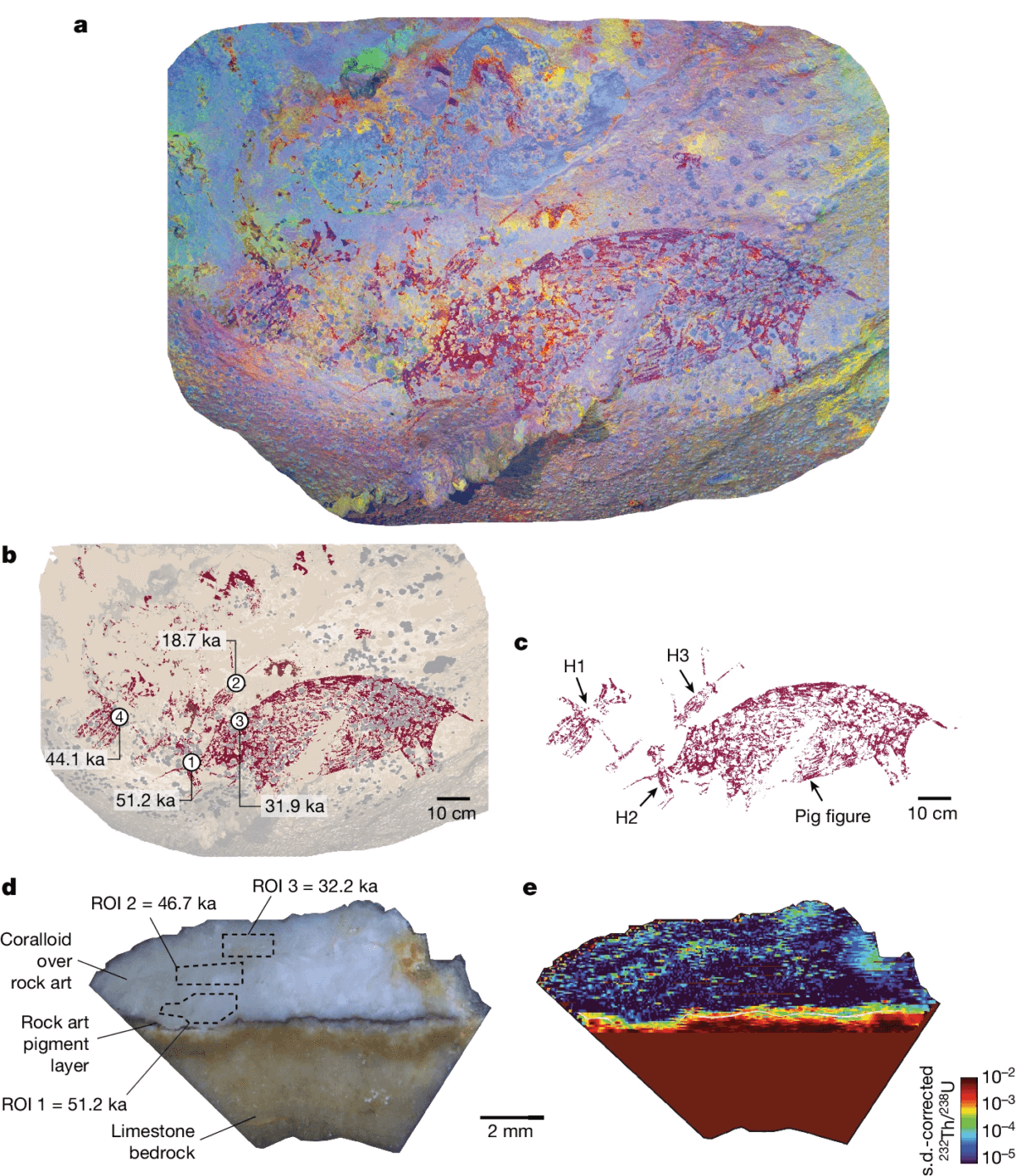
Photo-stitched panorama of the rock art panel (with photographs enhanced using DStretch_ac_lds_cb). (Credit: Nature/Griffith University)
QUEENSLAND, Australia — The tale of early humans hunting pigs roughly 50,000 years ago may be the first recorded story in human history. Deep in the limestone caves of Indonesia's Sulawesi island, this remarkable cave painting discovery has pushed back the origins of narrative art by thousands of years.
Researchers in Australia have found that our ancestors were creating complex scenes of human-animal interaction at least 51,200 years ago – making this the oldest known example of visual storytelling in the world. The groundbreaking study focuses on two cave sites in the Maros-Pangkep region of South Sulawesi. Using advanced dating techniques, researchers have determined that a hunting scene at Leang Bulu' Sipong 4 cave is at least 48,000 years-old, while a newly discovered composition at Leang Karampuang cave dates back at least 51,200 years.
“Our findings show that figurative portrayals of anthropomorphic figures and animals have a deeper origin in the history of modern human (Homo sapiens) image-making than recognized to date, as does their representation in composed scenes,” the study authors write in the journal Nature.
The Leang Karampuang artwork depicts at least three human-like figures interacting with a large pig, likely a Sulawesi warty pig. This scene predates the next oldest known narrative art by over 20,000 years, fundamentally altering our understanding of early human brain and artistic development.

A New Way to Date Ancient Art
Key to this discovery was the research team's novel approach to dating cave art. Previous studies relied on analyzing calcium carbonate deposits that form on top of paintings using a method called uranium-series dating. While effective, this technique had limitations when dealing with thin or complex mineral layers.
The researchers developed an innovative laser-based method that allows for much more precise analysis. By using laser ablation to create detailed maps of the calcium carbonate layers, they could pinpoint the oldest deposits directly on top of the pigments.
“This method provides enhanced spatial accuracy, resulting in older minimum ages for previously dated art,” the researchers explain.
The team applied this technique to re-date the hunting scene at Leang Bulu' Sipong 4, which was previously thought to be around 44,000 years-old. The new analysis revealed it to be at least 48,000 years-old – 4,000 years older than initially believed.
Pushing Back the Timeline of Human Art
Armed with this refined dating method, the researchers turned their attention to Leang Karampuang cave. There, they discovered and dated a previously unknown composition showing human-like figures apparently interacting with a pig.
Three small human figures are arrayed around a much larger pig painted in red ochre. Two of the human figures appear to be holding objects, possibly spears or ropes, while a third is depicted upside-down with its arms outstretched towards the pig's head.
Using their laser ablation technique, the team dated calcium carbonate deposits on top of these figures. The results were astounding – the artwork was at least 51,200 years-old, making it the earliest known example of narrative art in the world.
“This enigmatic scene may represent a hunting narrative, while the prominent portrayal of therianthropic figures implies that the artwork reflects imaginative storytelling (for example, a myth),” the international team writes.
Rewriting the History of Human Creativity
These findings have profound implications for our understanding of human brain development in ancient times. Previously, the oldest known figurative art was a painting of a Sulawesi warty pig from the same region, dated to 45,500 years ago. The oldest known narrative scene was thought to be the Leang Bulu' Sipong 4 hunting tableau, originally dated to 44,000 years ago.
The new dates push back the origins of both figurative and narrative art by thousands of years. They suggest that early humans in this region were engaging in complex symbolic thinking and visual storytelling (drawing and painting) far earlier than previously believed.
“This implies that a rich culture of storytelling developed at an early period in the long history of H. sapiens in this region — in particular, the use of scenic representation to tell visual stories about human–animal relationships,” the researchers write in Nature.
This research not only sheds light on the artistic capabilities of our ancestors but also provides insights into their thinking processes and social structures. The ability to create and understand narrative scenes in cave paintings implies complex language skills and the capacity for abstract thought.
As scientists continue to uncover and analyze ancient art, we may need to revise our timelines of human cultural and cognitive evolution. The caves of Sulawesi have revealed that our ancestors were accomplished artists and storytellers tens of thousands of years earlier than we ever imagined.










